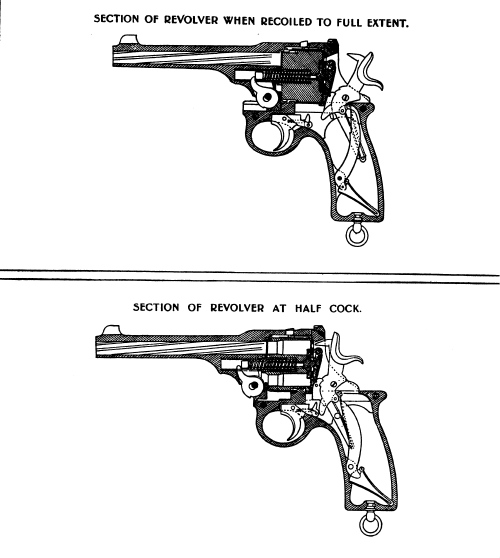Webley & Scott is a company famous for their revolvers. The top-break Webley is as much an icon of the British Empire as the Colt Peacemaker is of the Old West. What many are not aware of is that Webley also manufactured autoloading pistols, beginning with an attempt to interest the British army in one 'way back in 1905. That attempt failed, and Webley contented themselves with turning out a line of pocket autoloaders before making another attempt at a military contract with a new .455 caliber self-loader in 1913.
Webley & Scott Rifles
The Webley Self-Loading Pistol was an early magazine-fed pistol. The gun was designed in 1910 by the Webley & Scott company. 1 entered police service in 1911 in a.32 ACP model for the London Metropolitan Police.The.455 version was adopted by the Royal Navy in 1912 as the first automatic pistol in British service. The pistol was also adopted by the Royal Horse Artillery and the Royal. More pics like Lot 578:.Webley & Scott.22 Single Shot Target Pistol Lot 578.22 RF LR caliber, 9 7/8' barrel, S/N N3417. Parkerized finish barrel with blue finish frame. Webley & Scott immediately tendered the.38/200 calibre Webley Mk IV revolver, which as well as being nearly identical in appearance to the.455 calibre Mk VI revolver (albeit scaled down for the smaller cartridge), was based on their.38 calibre Webley Mk III pistol, designed for the police and civilian markets.
Webley Scott Pistol Drawing Kit
Photo by Oleg Volk.
I had to have it.
Unusually heavy, yet with an awkward grip angle, the pistol points like you're holding a t-square and may be the homeliest non-Japanese handgun I've ever seen. Oddly for a gun so rare, repro grips are available, and Triple-K has catalogued magazines. Cartridge cases can be made by trimming .45 Colt brass to length, turning the rim down somewhat (the .455 Webley Automatic is a semi-rimmed cartridge) and machining an extractor groove. The barrel rides in two angled mortises in the frame, and locks up very much like a SIG: a squared shoulder atop the chamber mating into the ejection port atop the slide. Everything is intricately machined from big chunks of steel and fitted together to a fare-thee-well.


Values on these things are all over the map, but a firing example would seem to be at least an $800-$1000 proposition pretty much regardless of finish. The much rarer Royal Horse Artillery model, with its exotic rear sight and slotted for a shoulder stock, commands prices well north of $2k on the infrequent occasions when one comes up for sale.
| Webley Self-Loading Pistol Mk. 1 | |
|---|---|
| Type | Semi-automatic pistol |
| Place of origin | United Kingdom |
| Service history | |
| In service | 1910–1942 |
| Used by | United Kingdom |
| Wars | World War I World War II |
| Production history | |
| Designer | Webley & Scott |
| Designed | 1910 |
| Manufacturer | Webley & Scott |
| Produced | 1910–1932 |
| Specifications | |
| Mass | 1.13 kilograms (2.5 lb) |
| Length | 216 millimetres (8.5 in) |
| Barrel length | 127 millimetres (5.0 in) |
| Cartridge | .455 Webley Auto |
| Caliber | .455 in (11.55 mm) |
| Action | Short recoil |
| Muzzle velocity | 236 metres per second (770 ft/s) |
| Feed system | 7-round detachable box magazine |
The Webley Self-Loading Pistol was an early magazine-fed pistol. The gun was designed in 1910 by the Webley & Scott company. The Mk. 1 entered police service in 1911 in a .32 ACP model for the London Metropolitan Police. The .455 version was adopted by the Royal Navy in 1912 as the first automatic pistol in British service. The pistol was also adopted by the Royal Horse Artillery and the Royal Flying Corps.[1] Its predecessor was the unsuccessful Mars Automatic Pistol.
Problems[edit]
The pistol's original cordite cartridge left a lot of residue in the barrel causing frequent jamming. This was resolved in 1914 with nitrocellulose instead of cordite in the .455 cartridge. This new cartridge for the Mk.1 was called the Mark Iz.

Had Webley invested in more research and development of its pistol and ammunition and new technologies, the result would have been a better firearm produced more quickly. Particularly given the increasing adoption of the semi-automatic pistol by foreign armed forces and the extensive testing and development data available from previous efforts by other manufacturers.[2]
Improvements and variations[edit]
The first models of the Mk. 1 had the safety on left side of the hammer. This was later moved to the left side of the frame, where it could lock the slide. Service versions were also outfitted with a grip safety.
All Discussions. Don't Starve Hamlet Beta Topic Details. Dec 8, 2018 @ 1:16pm Suspicious Crack (Hamlet) Does anyone know how to open these? I've already tried the ballpeen hammer, regular hammer, magnifying glass, pickaxe, and even some gunpowder. Is there a more powerful explosive I haven't. In Don't Starve: Hamlet, Wilson discovers a lost town of aristocratic Pigmen nestled within a foreboding tropical jungle. Can you readjust to society as an outsider? Can you earn fame and riches recovering lost relics? Will you weather the Aporkalypse? Reacquaint to city life: Visit shops and trade with the pig society.

Values on these things are all over the map, but a firing example would seem to be at least an $800-$1000 proposition pretty much regardless of finish. The much rarer Royal Horse Artillery model, with its exotic rear sight and slotted for a shoulder stock, commands prices well north of $2k on the infrequent occasions when one comes up for sale.
| Webley Self-Loading Pistol Mk. 1 | |
|---|---|
| Type | Semi-automatic pistol |
| Place of origin | United Kingdom |
| Service history | |
| In service | 1910–1942 |
| Used by | United Kingdom |
| Wars | World War I World War II |
| Production history | |
| Designer | Webley & Scott |
| Designed | 1910 |
| Manufacturer | Webley & Scott |
| Produced | 1910–1932 |
| Specifications | |
| Mass | 1.13 kilograms (2.5 lb) |
| Length | 216 millimetres (8.5 in) |
| Barrel length | 127 millimetres (5.0 in) |
| Cartridge | .455 Webley Auto |
| Caliber | .455 in (11.55 mm) |
| Action | Short recoil |
| Muzzle velocity | 236 metres per second (770 ft/s) |
| Feed system | 7-round detachable box magazine |
The Webley Self-Loading Pistol was an early magazine-fed pistol. The gun was designed in 1910 by the Webley & Scott company. The Mk. 1 entered police service in 1911 in a .32 ACP model for the London Metropolitan Police. The .455 version was adopted by the Royal Navy in 1912 as the first automatic pistol in British service. The pistol was also adopted by the Royal Horse Artillery and the Royal Flying Corps.[1] Its predecessor was the unsuccessful Mars Automatic Pistol.
Problems[edit]
The pistol's original cordite cartridge left a lot of residue in the barrel causing frequent jamming. This was resolved in 1914 with nitrocellulose instead of cordite in the .455 cartridge. This new cartridge for the Mk.1 was called the Mark Iz.
Had Webley invested in more research and development of its pistol and ammunition and new technologies, the result would have been a better firearm produced more quickly. Particularly given the increasing adoption of the semi-automatic pistol by foreign armed forces and the extensive testing and development data available from previous efforts by other manufacturers.[2]
Improvements and variations[edit]
The first models of the Mk. 1 had the safety on left side of the hammer. This was later moved to the left side of the frame, where it could lock the slide. Service versions were also outfitted with a grip safety.
All Discussions. Don't Starve Hamlet Beta Topic Details. Dec 8, 2018 @ 1:16pm Suspicious Crack (Hamlet) Does anyone know how to open these? I've already tried the ballpeen hammer, regular hammer, magnifying glass, pickaxe, and even some gunpowder. Is there a more powerful explosive I haven't. In Don't Starve: Hamlet, Wilson discovers a lost town of aristocratic Pigmen nestled within a foreboding tropical jungle. Can you readjust to society as an outsider? Can you earn fame and riches recovering lost relics? Will you weather the Aporkalypse? Reacquaint to city life: Visit shops and trade with the pig society. Don't Starve: Hamlet is not quite done. We have some items and balancing we want to finish before Early Access lifts in December. But there is still much to explore in the world and if you are the kind of person who is not afraid to stumble into an unfinished area, or use an unfinished feature, we would also love to hear any feedback you have. The cracked area can be destroyed using Gunpowder, Coconades, Slurtle Slime, a Weather Pain, or by causing a cave-in with a nearby Unimportant Pillar. Upon being destroyed, if there is no door there will be a solid section of wall. If there is a door it will now show up as a pathway on the Ruins map. Everything about Don't Starve, a survival game by Klei Entertainment, creators of Mark of the Ninja, Shank and N+, among many others. Currently available on Steam, GoG, PS4, XBox One, Switch and mobile.
References[edit]
- ^McNab, Chris (2009). Firearms, The Illustrated Guide to Small Arms of the World. Bath, UK: Parragon. p. 78. ISBN978-1-4075-1607-3.
- ^Kinard, Jeff (2004). Pistols: An Illustrated History of Their Impact. ABC-CLIO. p. 167; 397. ISBN978-1-85109-470-7.
Soon after World War II the major powers all but abandoned the revolver for standard issue
